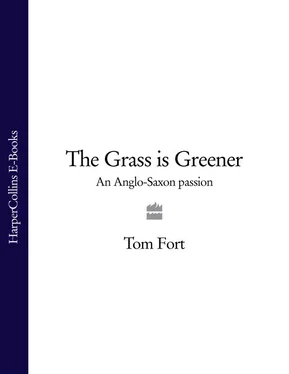Passion was excited by the great advances in the science of botany and the ever-increasing availability of new plants. That ardour for the new triggered by pioneers such as the Tradescants, father and son, had enormously expanded the horticultural horizon. But on the whole, the grandees who commissioned the great gardens were not that exercised by subtle distinctions between varieties of gillyflower or nasturtium (although tulips, notoriously, were another matter). They were more inclined to involve themselves in novelties such as statuary and hydraulic engineering, and, in particular, topiary. The new king and queen, William and Mary, had brought with them from Holland their fondness for evergreen hedges and bushes, which clamoured for some artist with a pair of shears to work them into a resemblance of a camel or a griffin or some other diverting shape.
The desire common to the great men, of course, was that their trappings – including their gardens – should reflect and display their greatness. As is the way with the species, whatever image of greatness one great man presented to the world, another would seek to surpass it. Few strove harder, at greater expense and with more magnificent if ridiculous results, than James Brydges, successively Lord Chandos, Earl of Carnarvon, Viscount Wilton and Duke of Chandos, whose name is perpetuated in the series of anthems written in his honour by Handel.
The man who thought nothing of commissioning the greatest composer of the age to sing his praises had a home to match his estimation of his own importance, and gardens in proportion. The main parterre at Canons in Middlesex was studded with life-size statues, most prominent among them a gladiator who stood beside a canal fed with water piped from springs at Stanmore two miles away. The divisions of the parterre, most unusually, were of decorative ironwork. Vegetables were grown under beehives of glass. At the end of each of the eight intersecting alleys was a lodging for a retired army sergeant who, together, formed a guard for the place. There were flamingos, ostriches and blue macaws, and eagles which drank from stone basins. Tortoises from Majorca crept through the undergrowth, in little danger of straying outside the boundaries of an estate each of whose main avenues of trees was more than half a mile long. And there was turf at Canons, grown from seed imported, for reasons which remain obscure, from Aleppo. It must have thrived and been extensive, for when Chandos’s fortunes were at their zenith, it was scythed three times a week and weeded daily.
Miles Hadfield suggests a close correspondence between the layout of the gardens at Canons and an influential book entitled The Theory and Practice of Gardening , first published in 1713 under the name John James, for many years Clerk to the Works at Greenwich. This was, in fact, a fairly close translation of a work by a Parisian, Antoine Joseph Dezallier D’Argenville, who had studied with a pupil of the great Le Nôtre, and was, therefore, a textbook for an essentially French school of design.
To be honest, there is little pleasure to be had from studying The Theory and Practice today. It is as short on charm and humour as Hillard and Botting’s First Latin Primer . But one can understand why John James’s cluster of aristocratic subscribers were so taken with it. It presents, not reflections or suggestions or philosophical aspirations, but prescriptions, precisely plotted and illustrated with encyclopaedic thoroughness. There are pages and pages of elaborate designs to choose from, which offer – or appear to – a guarantee of success. At the same time, the book does have, in its pedagogic fashion, dirty fingers. The nobleman, desirous of stamping the reflection of his nobility on his domain, might select a suitable rectangular plan. His head gardener, assuming he could read, could then learn how to put it all into practice. No one before had made available such a reliable, all-encompassing code of gardening conduct.
Anyone interested in the evolution of the lawn and grass culture has particular reason to be grateful to Mr James of Greenwich, for he tackles the subject with great thoroughness – or, perhaps, one should say that D’Argenville does. But, curiously enough, while the main design fundamentals expounded in The Theory and Practice are undoubtedly French in origin and inspiration, the section dealing with grass is not. D’Argenville graciously concedes the case:
You cannot do better than follow the method used in England, where their grass plots are of so exquisite a beauty that in France we can scarcely hope to come up with it.
The essence of the overall doctrine is what James calls ‘contrariety’ – the ‘placing and distributing the several parts of the garden always to oppose them one to the other’. It would be tedious to delve into the detail of its application. Suffice to say that the importance of turf is properly recognized. ‘A bowling green’, James reflects, ‘is one of the most agreeable compartments of a garden and when ’tis rightly placed, nothing is more pleasant to the eye.’ It demands, he adds, ‘a beautiful carpet of turf very smooth and of a lovely green’. He proceeds to a succession of alternative plans, each presented with immense care. In one, the square of the green is edged in box and pierced with a star of paths, with a rounded hollow at the centre. Another is oval, ‘cut in Carts to make a diversity’. There is a Great Bowling Green, ‘adorned with a Buffet of Water made against the slope’; and an even greater one with compartments ‘cut and tied together by Knots and Cartoozes of Embroidery, very delicate’.
In the Jamesian garden, the principal feature is the parterre (French, derived from the Latin partire , to divide), which was regularly shaped, usually edged in box, and intricately designed in patterns of gravel, sand, box, flowers, shrubs, trees or grass. The grass parterre was known as the ‘parterre à l’Angloise’, and should, according to the master, ‘consist only of large grass plots all of a piece, or cut but little’.
These days the exemplars on which the Frenchman and his English disciple lavished such care are no more than historical curiosities; symptoms of a preoccupation with orderliness and control which seems almost obsessive. But John James’s instructions on how to get things to grow contained many of the eternal truths. All subsequent manuals on creating a lawn – up to and including those of our own Doctor Hessayon – elaborate on the principles laid down almost three hundred years ago. The ground should be dry, broken up, the stones raked and removed. A ‘good mold’ should be thrown on. Flat ground should be seeded, slopes turfed. The seed should be sown very thickly, then raked in. ‘Chuse a mild day rather inclined to wet,’ says The Theory and Practice , ‘that the rain, forcing down the earth and sinking the seed, may cause it to shoot up the sooner. Do it in autumn rather than spring which can require continual waterings which is a very great slavery and expense.’
These are, quite simply, the immutable fundamentals of making a lawn. Nor is the master any less sound on the pitfalls. ‘All the difficulty of making a fine green plot by sowing has in getting good seed.’ He delivers a stern warning: ‘You should not do, as many, that will gather their seed from some hayloft and sow it without distinction … the seed shooting too high, making large stalks, the lower part remains naked and bare, and mow it as often as you will it will never make handsome grass.’ James is vague on where you should obtain your seed; understandably, since a century and a half later gardening writers were still bemoaning the difficulty in finding decent seed. Turf, he says, should be taken from road sides or from the edges of pastures and meadows where cows and sheep feed.
Читать дальше












